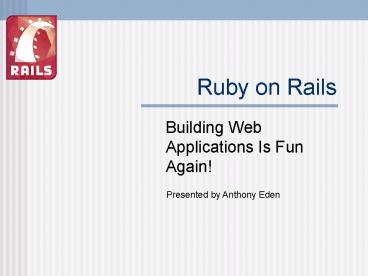Ruby on Rails - PowerPoint PPT Presentation
1 / 17
Title:
Ruby on Rails
Description:
Building Your First App. Create a new Rails app by typing: rails myapp ... Relationships are through primary keys. Supported relationship types: ... – PowerPoint PPT presentation
Number of Views:76
Avg rating:3.0/5.0
Title: Ruby on Rails
1
Ruby on Rails
- Building Web Applications Is Fun Again!
2
What is Ruby on Rails?
- Web application framework written in Ruby
- Ruby is an Object Oriented scripting language
- Model-view-controller
- Database agnostic
- Open source
- Lots of nice tools, classes and methods to make
development easier
3
The Rails Way
- DRY (Dont Repeat Yourself)
- Convention over configuration
- Baked in testing
- Minimal code with maximum effect
4
Getting Started
- Installing Ruby, Gem and Rails
- Install Ruby OCI8 Driver
- Connect using TNSNAMES.ORA
- Connect using InstantClient and a URL
- More information on wiki.rubyonrails.com
5
Rails on Oracle
- Key generation assumes sequences for each table
with the name table_name_seq - Sequence name can be changed using
ActiveRecordBase.set_sequence_name - Timezones and sub-second precision not supported
- More info http//wiki.rubyonrails.com/rails/pages
/Oracle
6
Building Your First App
- Create a new Rails app by typing rails myapp
- Edit the config/database.yml
- Generate a model using script/generate model
MyModel - Creating a model creates a class and a migration
7
ActiveRecord Conventions
- Naming convention simplifies development and
encourages good database design - Tables are plural, models are singular
- Example
- Model LineItem
- Table line_items
- Handles non-regular pluralization such as
Person/people - Can be overridden, although this complicates
things for the developer
8
Database Migrations
- Database agnostic means of defining schema
- Lowest-common-denominator approach
- Ruby code with full access to ActiveRecord
- Methods for creating, altering and dropping
tables, columns and indexes - Can execute arbitrary SQL with execute method
9
ActiveRecord Models
- Object/Relational Mapping
- Model classes extend from ActiveRecordBase
- ActiveRecordBase provides
- Database agnostic record creation, finding,
saving and removal - Data validation methods
- Relationships
- All in an easy to use package
- Rails encourages keeping business logic in the
model where it belongs - AR can be used outside of web applications
10
Views
- Responsible for creating part or all of the page
displayed in a browser - By default uses ERb (Embedded Ruby)
- Other views include builders for XML documents
or RJS templates to generate JavaScript for AJAX
driven views - Includes elegant means for including helper
functions for rendering - Supports partials and components
11
Controllers
- Generate controllers with script/generate
controller MyController - Controllers tie the view to the model through
actions - Controllers also have access to helpers
- Designed for people-friendly URLs
- Provides caching, session management, query
parsing, cookie management, pagination
12
ActiveRecord Relationships
- Relationships are through primary keys
- Supported relationship types
- belongs_to (book belongs to author)
- has_one (book has one publisher)
- has_many (book has many pages)
- has_and_belongs_to_many (book has and belongs to
many readers) - has_many through (book has many contributors
through contributions)
13
ActiveRecord Validation
- validates_presence_of
- validates_uniqueness_of
- validates_confirmation_of
- validates_acceptance_of
- validates_associated
- validates_each
- validates_format_of, _length_of
- validates_exclusion_of, _inclusion_of
14
More ActiveRecord
- Acts As
- acts_as_list (position)
- acts_as_tree (parent_id)
- Aggregations
- composed_of
- Callbacks
- Full lifecycle
- Before and after validation, creation, saving,
destroying - Calculations
- average, count, maximum, minimum, sum
15
Just When You Thought You Had Enough ActiveRecord
- Callback objects
- Observers
- Façade columns
- Object-level transaction management
- Magic column names
- created_on, created_at, updated_on, updated_at
auto timestamping and dating - lock_version and optimistic locking
- type for single table inheritence
- xxx_count counter cache
16
Other Stuff
- ActionMailer for sending mail messages
- ActionView helpers
- Form helpers
- Asset tags
- Javascript support (yummy AJAX!)
- Pagination
- Text helpers
- ActionWebService
- Ruby language extensions
- Breakpoint and debugging
17
Where To Go Next?
- http//www.rubyonrails.com/
- http//api.rubyonrails.com/
- http//wiki.rubyonrails.com/
- Agile Web Development with Rails
- http//www.ruby-doc.org/ for Ruby
- Programming Ruby
- IRC, Mailing Lists, Seth Ladds brain

